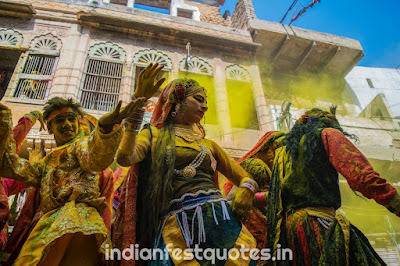Holi is a popular festival celebrated in India and Nepal, also known as the "Festival of Colors" or the "Festival of Love." It is celebrated on the full moon day in the Hindu month of Phalguna, which usually falls in February or March. Holi is a joyous occasion that brings people together to celebrate the arrival of spring, the victory of good over evil, and the triumph of love.
The origins of Holi can be traced back to ancient Hindu mythology. According to one popular legend, King Hiranyakashipu, a powerful demon king, was granted a boon by Lord Brahma that he could not be killed by any human or animal, during any day or night, inside or outside, with any weapon or weaponless. King Hiranyakashipu began to believe that he was invincible and started to torment the people, demanding that they worship him as a god. However, his own son, Prahlad, refused to worship him and instead continued to worship Lord Vishnu. Enraged by his son's defiance, King Hiranyakashipu tried to kill Prahlad in various ways, but all his attempts failed.
Finally, King Hiranyakashipu's sister, Holika, who had been given a boon that she could not be burned by fire, decided to kill Prahlad by sitting in a burning pyre with him. However, due to the power of Lord Vishnu, Prahlad remained unscathed while Holika was burned to death. This event is celebrated as Holi, symbolizing the victory of good over evil.
Another popular legend associated with Holi is the story of Lord Krishna and Radha. Lord Krishna, who was known for his love of colors, would playfully smear colors on Radha and the gopis (cowherd girls) of Vrindavan. This playful behavior of Lord Krishna is believed to have started the tradition of playing with colors on Holi. Holi is celebrated in various ways across India and Nepal. People gather in open spaces, smear each other with colored powder and water, and exchange sweets. Traditional sweets like gujiya, mathri, and thandai are prepared and shared among friends and family. People also light bonfires, known as Holika Dahan, to symbolize the burning of the demon king Hiranyakashipu's sister, Holika.
One of the most significant aspects of Holi is the idea of forgiveness and forgetting past grudges. On this day, people forget their past conflicts and reconcile with their loved ones. It is a time to let go of the past and start fresh. Holi is a reminder that no matter how dark our past may be, there is always hope for a brighter future. Holi also has a strong cultural significance. It is a celebration of the arrival of spring and the end of winter. The festival is celebrated with great enthusiasm, especially in North India where the winter is harsh. People come out of their homes and celebrate the festival with great joy, forgetting their worries and sorrows. The festival of colors is a symbol of the arrival of new beginnings, new life, and new hope.
Holi is also a celebration of love and unity. The festival brings people of all ages, castes, and religions together to celebrate. People exchange sweets and greetings with each other, regardless of their social status. It is a day when everyone is equal, and there is no discrimination. In conclusion, Holi is a festival that has deep cultural and religious significance. It is a celebration of the victory of good over evil, the arrival of spring, and the triumph of love.
Thanks for visiting indianfestquotes.in
Hope you enjoyed reading it. For more informations and wishes check our website.
Happy Holi









0 Comments